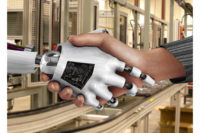Engineers, by their very nature, tend to be builders and tinkerers. Nonetheless, faced with an automation project, they need to think long and hard before taking on the work themselves. Without the right type of game plan, an in-house project can easily turn into an expensive, time-consuming nightmare.
Ultimately, there is no one-size-fits-all approach to the build-or-buy question. The answer depends on factors such as time constraints, the size of the manufacturer and the assembly application.
"Company culture and history play a role in this decision," says Steve Botos, vice president of sales and marketing at Aerotech Inc. (Pittsburgh). "Two companies in the same industry can have two completely different approaches to the in-house, out-of-house decision."
Walt Hessler, vice president of sales and marketing at PHD Inc. (Fort Wayne, IN), agrees. "The big question is ‘do we have the expertise and staff to tackle an in-house project?' For some companies, it's not an option. It would be ludicrous to do it in-house."
Not surprisingly, given the resources at their disposal, most manufacturers pursuing the do-it-yourself route are Fortune 500 companies with large in-house engineering and manufacturing departments. For example, aerospace manufacturer Boeing (Chicago) has developed a system of in-house "moonshine" groups that prototype equipment, and then actually build devices and put them into production. Over the years, the company has saved million of dollars in capital equipment expenses, building a wide variety of devices, such as conveyors, fastening equipment and machine tools.
According to Mike Herscher, lean enterprise office leader for Boeing's commercial airplanes division, the moonshine groups tend to be made up of individuals who enjoy taking apart motorcycles or repairing mechanical watches and clocks in their spare time. "They're [located] in the factory that's building the part they're building equipment for; they're not a separate group off-site somewhere," Herscher says. "We can build 90 percent of anything that we can buy."
Of course, not every manufacturer has the resources or unique requirements of Boeing. Many companies are so lean they no longer have the internal resources needed to build equipment in-house. In fact, many observers say that, because of outsourcing and downsizing, they see fewer manufacturers tackling automation projects in-house today than in the past.
Still, for those with the wherewithal, there are several advantages to building equipment in-house. For example, consumer product and medical device manufacturers often create their own equipment to avoid revealing highly proprietary processes to outsiders. Similarly, do-it-yourself automation allows companies to maintain greater control over the design, and because decisions are not left in the hands of a machine builder, engineers can set their own priorities and timetables, avoiding potential delivery delays. Finally, many engineers see in-house projects as an opportunity to learn and hone new technical skills.
Unfortunately, on the down side, while engineers traditionally believe the do-it-yourself approach to machine building is less expensive than buying turnkey solutions, the reality is that costs can easily get out of control.
For example, manufacturing engineers are often overly optimistic as to their availability to work on in-house projects and their ability to stay committed over the long-term. It can also be easy to lose track of the costs of incidental materials, such as plating, fittings, wiring and hoses. Although not as obvious as big-ticket items, these components comprise a major portion of the functionality of the equipment.
There can also be a tendency to overestimate internal capability and underestimate the time needed to get the job done. Again, engineers tend to overlook the hidden costs. Many will focus on materials and parts cost, but overlook the cost of ownership. They don't consider start-up costs, debugging time, warranties or applications support. These expenses are often hidden when equipment is built in-house. Many well-intentioned projects suffer from artificially low in-house costing estimates.
Finally, a big disadvantage of building automation systems in-house is not being able to tap into the expertise of machine builders and systems integrators that have many years of experience in automation applications. "Our customers are very good engineers, but their expertise is usually in areas specific to their businesses and not necessarily in automation or motion control," says Aerotech Inc.'s Botos. "Engineering time is a finite resource. Opportunity costs are real costs that are sometimes not taken into consideration. [Manufacturers] must ask themselves how they want to allocate their time and resources."
In a similar vein, Mark Dinges, product manager for conveyors at Bosch Rexroth Corp. (Buchanan, MI) warns there is no check-and-balance system with in-house projects to ensure that the optimum automation solution or technology has been chosen for the project. By not taking advantage of outside expertise, a company may indeed find a "solution" to its problem. But there may have been a more viable and economical off-the-shelf solution that was overlooked.
"If you are buying ‘garden variety' components for your [in-house] product or process, you will get a commensurate garden variety performance out of your system," Botos warns.
This is not to say that engineers should never try to tackle and automation project on their own. It's just that they need to be careful.
"Size, complexity and timing are three of the primary factors in determining whether to tackle an automation project in-house or not," says Dinges. "An extension to an existing assembly system or a small assembly system with minimal process controls may be a good candidate for an in-house automation project. In particular, the availability of pre-engineered modular components, such as nonsynchronous conveyors and aluminum structural framing, have simplified and shortened the design process, thereby allowing in-house engineers to take on some small projects that they may have outsourced otherwise."
